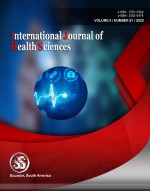Evaluation of nurses’ practices about management of main danger signs during pregnancy
Keywords:
nurses' practice, management, pregnancy, danger signsAbstract
Background: Globally, an estimated 10.7 million mothers died from 1990 to 2015 due to obstetric complications and maternal mortality remains high in developing countries.
Objective: the study aimed to evaluate nurses’ practice regarding the management of pregnancy with danger signs and to find out the relationship between these nurses’ practice and their demographic characteristics. Methodology: A descriptive study design was carried to evaluate nurses’ practice. A non-probability (purposive sample) of (50) of nurse who work in emergency words, labor room and maternal words. The questionnaire consists of two main parts (the first one is about nurses’ demographic characteristics and the second is nurses’ practice about managing danger signs in pregnant women).Results: The overall assessment of nurses’ practices about management of pregnancy with danger signs; the findings reveal that nurses are showing fair level of practices (78.14±5.047) among (96%) Conclusions: nurses’ practice about management of pregnancy with danger signs was fair level of practice.
Downloads
References
Mbizvo, M. T., & Say, L. (2012). Global progress and potentially effective policy responses to reduce maternal mortality. International Journal of Gynecology & Obstetrics, 119, S9-S12.
World Health Organization. (2015). Trends in maternal mortality: 1990-2015: estimates from WHO, UNICEF, UNFPA, World Bank Group and the United Nations Population Division. World Health Organization.
Thapa, B., & Manandhar, K. (2017). Knowledge on obstetric danger signs among antenatal mothers attending a tertiary level hospital, Nepal. Journal of College of Medical Sciences-Nepal, 13(4), 383-387.
Filby, A., McConville, F., & Portela, A. (2016). What prevents quality midwifery care? A systematic mapping of barriers in low and middle income countries from the provider perspective. PloS one, 11(5), e0153391.
Fransen, A. F., van de Ven, J., Banga, F. R., Mol, B. W. J., & Oei, S. G. (2020). Multi‐professional simulation‐based team training in obstetric emergencies for improving patient outcomes and trainees' performance. Cochrane Database of Systematic Reviews, (12).
Centers for Disease Control and Prevention (2016). Pregnancy complications, available at https://www.cdc.gov/reproductivehealth/maternalinfantheal th/pregcomplications.htm, accessed on Dec.28.2019.
Gebrehiwot, H., Bahta, S. and Haile, N. (2014) ‘Awareness of Danger Signs of Pregnancy and its Associated Factors among Pregnant Women who Visit ANC in Mekelle Public Hospitals’, American Journal of Advanced Drug Delivery, 2(2), pp. 164–173.
Prithi, A., Reddy, A. D., Deepthi, Y. S., & Venkatesh, R. R. (2018). Preeclampsia: Risk Factors, Complications And Management. World Journal of Pharmaceutical Research, 7(13), 1026.
Crofts, J. F., Mukuli, T., Murove, B. T., Ngwenya, S., Mhlanga, S., Dube, M., ... & Sibanda, T. (2015). Onsite training of doctors, midwives and nurses in obstetric emergencies, Zimbabwe. Bulletin of the World Health Organization, 93, 347-351.
World Health Organization. (2019). World health statistics overview 2019: monitoring health for the SDGs, sustainable development goals (No. WHO/DAD/2019.1). World Health Organization.
The Asean Secretariat (2018) ASEAN Statistical Yearbook, 2018. Jakarta.
Bolarinwa O. (2015). Principles and methods of validity and reliability testing of questionnaires used in social and health science researches. Nigerian Postgraduate Medical Journal; 22(4): 195-201. Retrieved from https://www.npmj.org/article
El Sharkawy, A. T., Ali, F. K., & Araby, O. A. (2020). The Effect of Simulation-Based Educational Program on Maternity Nurses' Performance regarding Obstetrical Emergencies during Pregnancy. Evidence-Based Nursing Research, 2(4), 14-14.
Beydag, K. D. (2011). Knowledge and applications of the midwives and nurses at an educational hospital on the early diagnosis of cervix cancer. Asian Pacific Journal of Cancer Prevention, 12(2), 481-485.
Collins, C. (2009). Integrating behavioral and mental health services into the primary care setting. North Carolina medical journal, 70(3), 248-252.
World Health Organization. (2006). integrated Manangement of pregnancy and childbirth pregnancy, childbirth, postpartum and newborn care :A Guide for essential practice, world health organization Geneva, retived 18/3/2011from http://www.who.int/
Abdalmajed, S. A. S. (2018). Nurses’ Knowledge regarding Nursing Care of Pregnancy Induced Hypertension at Kassala Saudi New Hospital, Kassala State, Sudan (2018) (Doctoral dissertation, University of Gezira).
(Anaam, 2017),
Said, S. A. E., Saied, E. A. R., Gaafar, H. A. A., & El-Houfey, A. A. (2021). Effect of Simulation on Maternity Nurses' Knowledge, Practice and Self-efficacy During Management of Eclamptic Fits. International Journal of Nursing Education, 13(1).
Published
How to Cite
Issue
Section
Copyright (c) 2022 International journal of health sciences

This work is licensed under a Creative Commons Attribution-NonCommercial-NoDerivatives 4.0 International License.
Articles published in the International Journal of Health Sciences (IJHS) are available under Creative Commons Attribution Non-Commercial No Derivatives Licence (CC BY-NC-ND 4.0). Authors retain copyright in their work and grant IJHS right of first publication under CC BY-NC-ND 4.0. Users have the right to read, download, copy, distribute, print, search, or link to the full texts of articles in this journal, and to use them for any other lawful purpose.
Articles published in IJHS can be copied, communicated and shared in their published form for non-commercial purposes provided full attribution is given to the author and the journal. Authors are able to enter into separate, additional contractual arrangements for the non-exclusive distribution of the journal's published version of the work (e.g., post it to an institutional repository or publish it in a book), with an acknowledgment of its initial publication in this journal.
This copyright notice applies to articles published in IJHS volumes 4 onwards. Please read about the copyright notices for previous volumes under Journal History.
















